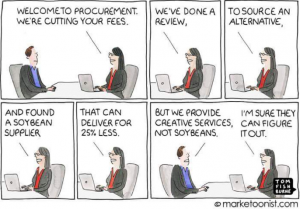Back to the work comp services business…
A while ago I wrote about how some buyers’ attitudes are a bit overbearing. I know, unusual for me to be rather subtle.
The post itself generated a few comments; many more were sent to me directly with the request they not be made public. I will always honor that request.
But…
Here are a few ways buyers mistreat “vendors”.
- The Jerk-Around
This begins pleasantly enough, with lunches and dinners and meetings building rapport and “relationships.” The buyer is really, really interested, voicing approval of the vendor’s product/service, requesting more information, discussing needs and priorities. The vendor is convinced the buyer is really interested, it’s just not the right time. Perhaps in a couple months.Then, a new management focus appears, and this is on the back burner for a bit. Oops, a change in systems resources is holding things up. It may be because the buyer is really trying to get a deal done. More likely, the buyer just doesn’t want to say “no”. While understandable, this is the wrong thing to do – for everyone.A fast No is far better than a long maybe.Yes, the sales person is at fault too. They should be asking, probing, talking with others at the buyer’s employer. But if they keep getting the wrong information and are led the wrong way, it’s easy to succumb.
- The Disappearing RFP
This starts with a voluminous request for proposal asking every possible question and attestation in multiple ways. It takes weeks of work by the vendor, pulling scarce resources away from other projects.And then…crickets.
Days become weeks, weeks stretch out into months, and months disappear into the void. Eventually everyone involved forgets what happened, who wrote what why, and where things stand. And the vendor has lost tens of thousands of dollars in labor costs…so has the buyer. Why payers go thru all the work to write an rfp only to abandon it, often without informing – and apologizing to – the respondents, is a mystery.
(Actually it isn’t…there are way more service providers with way more capacity then there are potential customers, so you’ve got no choice…you HAVE to respond to every RFP even though you know your chances are miniscule…)
What you’d LIKE to say…

- The Change-a-Thon
The original specs both parties agreed to are set forth in stone. Well, still-liquid mud actually, but mud is just stone that hasn’t solidified quite yet.Then, there’s a Note/email/change request… “due to regulatory issues, or a change in management, or because we just forgot something, we now need your data to feed this other system/comply with this standard/include these fields that we never told you we wanted, and/or your staff has to have the following credentials, and/or we need the reports on pink paper on Tuesday.”Oh, and we can’t pay you any more for this.Then there’s another change request, and another, and on it goes.
- The “We Need a Better Price”
You’ve negotiated everything, and it’s pretty much a done deal. Then the buyer – often a procurement person – says they need a better price. You’ve been hearing for months that the customer wants better service, is leaving their current vendor because of lousy service, and places a premium on service.Except they refuse to pay for it.So, you’re stuck. It’s either agree to barely break-even or perhaps even lose money, or agree to the price knowing you’re going to reneg on service once the contract is signed.Which leads to the final problem (although I’m sure you have your own list)
- The Procurement Problem
Oh boy. The business people have written the specs, delved deeply into your capabilities, certifications, experience, and results. They fully understand that the service they want – and what you are expert in – is hugely complex, requires deep experience and highly trained staff, and will evolve over time as you work together and learn how to do things smarter/faster.The procurement/purchasing folks have been involved, but up till now they’ve been pretty much silent.
Now they start negotiating price, and the dreaded Service Level Agreement (SLA). They want performance guarantees with financial penalties, but won’t agree to bonuses based on stellar achievements. They may demand you agree to specific time frames and project specs, refusing to factor in possible screwups/delays on their side of the implementation process. They negotiate price like a pitbull; in fact they focus most of their effort ratcheting down the price.Your business contacts plead with you to agree to the terms, saying they’ll work it out. Then, you’re locked in, and once again stuck in the “we can’t afford to deliver this for that price” – so it’s lose money or be accused of failing to deliver.

(Terrific insights into marketing and procurement here.)
(Now that I’ve thoroughly angered my friends in purchasing/procurement roles, know that some – a few – are reasonable, thoughtful professionals that seek to understand these issues and recognize the price implications.)
What does this mean for you?
You get what you pay for.
Workers comp services is a shrinking business in a highly mature market. The only way vendors grow is by taking business from a competitor. Buyers have all the negotiating power, and often use every bit of it to wring concessions from suppliers.
That’s almost always a grave mistake, leading to poor service and poor results.



Huzzah!
Thank you for laying out in clear language what is REALLY taking place in the claims industry…where service provider price (12% – 17% of total incurred loss) is give a far higher, if not highest, priority over the way the recovering workers are treated and, importantly, the total cost of the program. Save 2% at a cost of 20% is not uncommon.
Nice post Joe and I agree with your summation of the challenges in offering solutions to the workers compensation market; however, it is a two way street and sales professionals should be qualifying opportunities and asking clarifying questions throughout the sales process to gauge interest and overall direction of the buyers search for a better solution. Blind responses to RFP’s (just submitting a response with no relationship or history with the prospect) is an exercise in futility in my opinion.